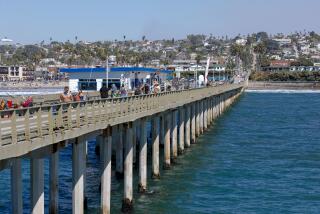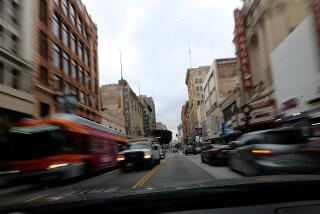Sinking Rated Slight : Eaton Crest Work on Hold, Agency Says
An attorney for the Los Angeles Community Redevelopment Agency said in court that the agency has suspended plans to make $10 million in repairs on two sections of the Monterey Hills development.
Agency counsel Laurie D. Zelon told jurors in a Los Angeles Superior Court trial Friday that a 1986 agency study, which said the repairs are necessary, is flawed. According to a study completed this spring, she said, the complex is sinking at a fraction of the rate previously believed and does not require extensive structural repairs.
The attorney’s statements came during opening arguments in a $10.5-million lawsuit brought by the Eaton Crest Homeowners Assn. against the agency and private firms involved in constructing the project. It is the second suit to go to trial of five brought by homeowner associations against the agency since homes in the development began tilting and cracking on an improperly compacted landfill several years ago.
Earlier Trial
In the trial earlier this year of a suit brought by the Drake Terrace Homeowners Assn., agency officials said repairs would be made to the Drake Terrace section as well as to Eaton Crest and another section of the 1,600-unit complex called Temple Terrace.
Eaton Crest and Temple Terrace sit on what was once Pullman Canyon. The area has been filled in with more than 100 feet of dirt. The agency assurances were central to its defense in the trial.
In a negotiated settlement after testimony concluded in that trial, the agency agreed to pay $6 million to the Drake Terrace homeowners and to spend $3 million to repair the damaged homes. The settlement did not address the repairs planned on the other sections of the complex.
After the settlement was reached, the agency commissioned some of the same soil engineers who wrote the 1986 study to review the settlement problems at Monterey Hills.
The new study, prepared in April, concludes that expensive repairs are unnecessary. It concludes “that the buildings are safe and sound now, will be in the future and will need no future repairs,” Zelon told jurors.
Engineer’s Conclusions
But James Slosson, the engineer who headed the team that prepared the 1986 report, said in pretrial depositions that he stands by its conclusion that the Pullman Canyon fill will sink an additional 16 to 18 inches. Slosson will testify for the plaintiffs in the trial, despite requests from the agency’s counsel to bar his testimony.
The complex trial--expected to last through November--pits more than 200 homeowners and the bond trustee on their mortgages, Security Pacific National Bank, against seven defendants, including the city of Los Angeles, the redevelopment agency, and private development and construction firms involved in every phase of the project.
Monterey Hills was built in the late 1970s on hilly terrain east of the Pasadena Freeway.
To speed the trial--which took more than six months to come before a jury--Judge Eli Chernow ordered the 15 attorneys representing various interests in the case to consolidate their arguments into two sets of opening statements for each side. Even so, the statements were interrupted frequently by objections and conferences with the judge.
The statements, Chernow said in
court after the jury left the room, were “the most litigated set of opening arguments I’ve ever heard.”
Attorneys for the homeowner association and the bank said $18.7 million will be necessary to repair the damaged homes, which have visible cracks in walls, ceilings and foundations.
In his opening statement, the homeowners’ attorney, Joel B. Castro, called the Monterey Hills complex “a nightmare” and “an experiment that failed.” He said expert witnesses will testify that the Eaton Crest buildings are steadily sinking.
He said real estate agents will testify that the homes have sunk below market value as well.
Zelon and other attorneys for the defendants in the case conceded in their opening statements that the Monterey Hills complex is damaged and that the homeowners are entitled to compensation, but said they would prove that the damage is cosmetic and requires less than $2 million in repairs.
They also said they will show that the homes can be resold at fair market value even if no repairs are done on the buildings.
More to Read
Sign up for Essential California
The most important California stories and recommendations in your inbox every morning.
You may occasionally receive promotional content from the Los Angeles Times.










